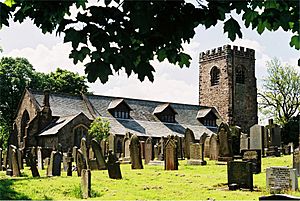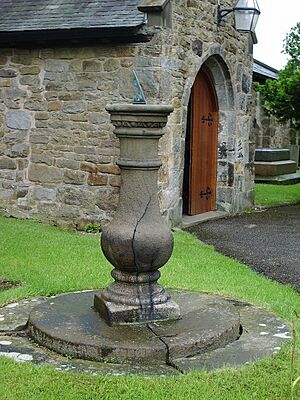St Mary's Church, Goosnargh facts for kids
Quick facts for kids St Mary the Virgin, Goosnargh |
|
|---|---|

St Mary's Church from the north
|
|
| Lua error in Module:Location_map at line 420: attempt to index field 'wikibase' (a nil value). | |
| OS grid reference | SD 55951 36922 |
| Location | Goosnargh, Lancashire |
| Country | England |
| Denomination | Anglican |
| History | |
| Status | Parish church |
| Architecture | |
| Functional status | Active |
| Heritage designation | Grade II* |
| Specifications | |
| Height | 60 feet (18 m) |
| Administration | |
| Deanery | Garstang |
| Archdeaconry | Lancaster |
| Diocese | Blackburn |
| Province | York |
The Church of St Mary the Virgin is an Anglican church located in Goosnargh. This is a village found north of Preston in Lancashire, England. The church is very old, dating back to the Middle Ages. It was made bigger in the 1500s and fixed up twice in the 1800s.
St Mary's is still an active parish church today. It belongs to the Diocese of Blackburn. English Heritage has given it a special status as a Grade II* listed building. This means it is a very important historical building.
Contents
A Look at the Church's History
St Mary's Church has been around since the Middle Ages. It was likely built by 1281, and definitely by 1330. It probably started as a small church, or "chapel of ease." This means it was a handy place for people to worship, helping out the main church in Kirkham.
Most of the church you see today is from the 1400s or later. For example, the tower and the north side of the church are from this time.
How the Church Grew Over Time
The church started to get bigger in the 1500s. The chancel, which is the area around the altar, was rebuilt in 1553. The south side of the church was also likely rebuilt around the late 1500s or early 1600s.
Later, in the late 1700s, a balcony was added at the back of the church. Another balcony was added in 1800, near the front.
Repairs and Updates in the 1800s
Between 1868 and 1869, a lot of important repairs happened. A company called Paley and Austin from Lancaster did this work. They fixed the roof and the stone around the windows. They also made changes to the seating inside the church. More repairs were done in 1895 to keep the old church in good shape.
St Mary's Church Today
St Mary's was officially named a Grade II* listed building on November 11, 1966. This special title means it's a "particularly important building." It has more than just special interest.
The church is still a busy place of worship for the Church of England. It is part of the Diocese of Blackburn. This diocese is in the Province of York. The church also belongs to the archdeaconry of Lancaster and the Deanery of Garstang.
Church Design and Features
St Mary's is built from sandstone rocks. It has special gritstone details and slate roofs. The church has a main area called the nave. It also has aisles on the north and south sides. There is a chancel at the east end, with balconies facing north and south. A tall tower stands at the west end.
There is a small entrance area, or porch, on the south-west side. A vestry, which is a room for clergy, is north of the chancel. Many parts of the church are built in the Romanesque style. The roof over the nave has small windows called gabled dormers. These let light into the church for everyone inside.
The Church Tower
The church tower is 60 feet (18 m) tall. It has three main sections. A small stair turret is on the south-east side. Strong supports called buttresses help hold up the tower. The top of the tower has a crenellated parapet, which looks like the top of a castle wall.
The tower also has three-light belfry louvres. These are openings for the bells. They have fancy stone patterns called Perpendicular style tracery. There is also a rounded arched doorway.
Inside the Church
The main part of the church, the nave, is about 70 feet 6 inches (21.49 m) long and 20 feet 6 inches (6.25 m) wide. It is separated from the side aisles by arcades. These are rows of pointed arches supported by eight-sided pillars.
At the east end of the north aisle is the Middleton Chapel. It has wooden screens that are from the late 1600s or 1700s. In the south aisle, there is a stone baptismal font. It is 1 foot 5 inches (0.43 m) tall and has a large square bowl. This font might be from the 1400s.
The Church Bells
The tower has six working bells. Each bell has an inscription:
- The first bell says, 'God preserve the Church and Queen Ann 1713'.
- The second bell says, 'Prosperity to the Church of England a.r. 1742'.
- The third bell says, 'Abr. Rudhall cast us all 1713'.
- The fourth bell says, 'Christopher Swainson A.M. minister, a.r. 1742'.
- The fifth bell says, 'Presented by R. Newsham esq. Mears and Stainbank 1883'.
- The largest bell says, 'I to the Church the living call and to the grave do summon all, 1753'.
Other Church Items
The church has a chalice from 1746. A paten, which is a plate used in communion, has a message. It says it was given to Goosnargh Church to remember Charles Osborne Gordon, who was the vicar (priest) and passed away on August 19, 1892. There are also other items like a plated chalice, a flagon, and a breadholder. The breadholder was given to the church in 1872 to remember William Shawe.
A pipe organ used to be in the west balcony. The organ used today is at the east end of the south aisle. It was built in 1906. The church also has beautiful Stained glass windows. These were made by artists like Shrigley and Hunt, Harry Stammers, and Heaton, Butler and Bayne.
The Churchyard
In the churchyard, you can find very old gravestones. One of them dates back to 1668. There are also war graves for four soldiers from World War I and one from World War II.
To the south of the church, there is a sandstone sundial. It has two round steps and a base shaped like a vase. A plate on it says July 1746 and has the name of Rev. C. Swainson. This sundial is also a Grade II listed building.
South of the chancel, you can see the stone base of a preaching cross. This cross base is from the late Middle Ages. It also has a Grade II designation, meaning it's an important historical item.
See also
- Listed buildings in Goosnargh
- List of ecclesiastical works by Paley and Austin


